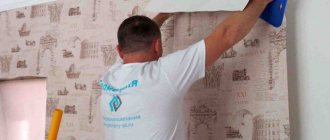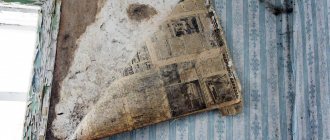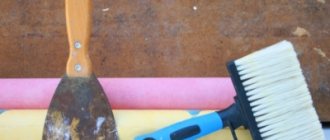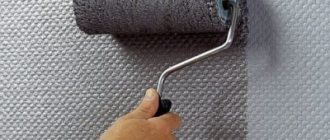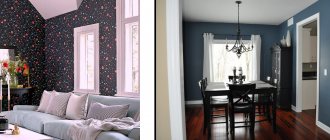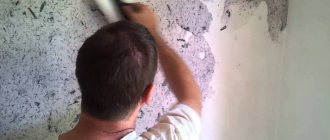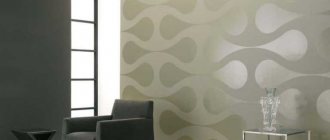To carry out repairs, residents of houses and apartments often hire specialists or prefer to do the finishing themselves. But sometimes the old wall covering is so difficult to remove that many begin to wonder whether it is possible to glue wallpaper onto wallpaper. In the standard procedure, the old finish is completely removed from the walls and only after that the new one is applied. But sometimes, in order to save effort, money, time, and simplify the procedure as much as possible, some people start gluing new wallpaper directly onto the old ones. At the same time, they eliminate the process of puttying and sanding the walls. But this method has a number of pros and cons; you should analyze in detail the cases when it can be used, and when the result of such repairs will look disastrous.
Is it possible to glue wallpaper onto old wallpaper?
If you look in detail at whether it is possible to glue wallpaper onto old wallpaper, the answer will be positive.
This can be done subject to the following restrictions:
- If the old layer has excellent adhesion to the wall and good adhesion. Attention should be paid to corner areas, joints, seams, where detachments and discrepancies are most often possible.
- Wallpaper should be glued to the smooth previous finish. On variants with ornaments, the coupling area will be significantly reduced, so the quality of the pasting may be significantly affected, and the service life of such a coating will be reduced.
- Any material must be glued to entire walls.
- It is best to choose wallpaper for the second layer in a dark shade with a large pattern. Thanks to this technique, the previous wallpaper will not show through, and a large ornament will be able to hide unevenness and roughness.
Advice! Before gluing the material over the old one, you need to pay attention to the type of finish that is already on the wall. Depending on the variety, you need to select a suitable new coating and gluing technique.
Pros and cons of gluing new paper wallpaper onto old paper wallpaper
Let's start, perhaps, with the most important thing. Old wall coverings will allow you to avoid additional energy-intensive costs of removing the outdated layer, leveling (puttying) the walls, and possibly new plastering.
The disadvantages include the need to check old wall coverings for integrity: they should not move away from the walls, have cracks, or have a rough surface. If one of the restrictions is violated, new wall coverings may simply fall off the walls. If you use wallpaper made of simplex paper (single-layer), you will need to choose a tone darker than the previous ones so that the design does not show through the new layer.
Paper
Is it possible to glue new wallpaper over old paper wallpaper? The answer is definitely positive. This is the most ideal base that can serve for many years. If paper wallpaper acts as a base, it allows you to avoid unevenness, bulges and roughness.
If you glue paper wallpaper in the second layer, it will stick well, quickly and easily and last a long time.
Advice! In the case of paper options, you need to select a color and pattern that is darker than the previous coating, since brighter colors below can show through the translucent paper.
If paper wallpaper was pasted on the wall, you can safely glue photo wallpaper on top of it. The main thing is that there are no roughnesses on their surface, since the thin material of the photo wallpaper makes any irregularities too noticeable.
Important! Before starting finishing work, you need to check the quality of adhesion of the old wallpaper, make sure that there are no bubbles or peeling on its surface. If found, cleaning is necessary so that contact with moisture does not damage the new repair.
Gluing rules
To successfully paste the selected wallpaper material onto already pasted walls, use the following recommendations:
- Be sure to make sure that the old canvases are held securely. You can lightly moisten the surface and then tear off the pieces of material extending from the base. The most common problem areas are the joints of the panels - inspect them carefully.
- Don't rush with gluing - start with one strip and wait until it dries. If everything is in order, then the test was successful and you can continue working.
- Limit the amount of adhesive - it should be sufficient, but not excessive. If you apply too much glue, the canvases will become soggy, heavy and may fall off after some time.
- Avoid air movement and drafts during work. The use of a convector, fan or air conditioner is prohibited; windows and doors must be closed.
USEFUL INFORMATION: How to properly hang ceiling wallpaper
Important! If a small number of bubbles appear on the surface after pasting, do not despair. You can try to smooth them out with a special spatula or even a simple iron. There is no need to be too zealous - after the surface has completely dried, they can smooth out on their own.
Vinyl
With vinyl wallpaper on the walls, things are more complicated. Neither a similar coating nor any other can be glued to vinyl wallpaper. They have a corrugated oilcloth surface to which other materials do not adhere well. The new layer will simply fall off if you glue them on top. Vinyl wallpapers themselves can be glued to old paper wallpapers, but in this case they will not last long as they are heavy. There is a high probability that they will simply begin to tear off the paper base, so it is important that the base has a strong adhesion to the wall.
Advice! If you choose vinyl wallpaper for gluing, in order to increase its service life, you still need to take the time to remove the old coating.
Non-woven
In most cases, many wallpapers are transparent, so gluing them onto old ones is simply not advisable, since they will be translucent. Is it possible to glue non-woven wallpaper onto old paper coverings? Experts will confidently say that it is not recommended, since it is a synthetic material in structure. It’s also not worth gluing new wallpaper over non-woven wallpaper, because it’s simply impossible. They usually have a very corrugated surface and a fairly smooth film coating, so it will be impossible to achieve a bonding effect.
Can all types of wallpaper serve as the basis for new ones?
If you decide not to remove the old covering, you must remember that not all modern wallpaper materials can be the basis for new wallpaper. For example, it is impossible to apply a new one to a finish decorated with a convex relief pattern. Glue on such a base will not be able to hold and the surface will be uneven.
Non-woven and vinyl sheets also cannot serve as the basis for a new finish, due to the presence of a protective film that will prevent the glue from deeply saturating the surface. This means that it will not be possible to glue new wallpaper efficiently, as it will quickly peel off and simply fall. It will also not work to glue new canvases onto liquid wallpaper.
Only paper wallpaper that does not have a convex pattern can serve as the basis for pasting.
Fiberglass
Such a common option as fiberglass must be glued to the prepared wall. It is not advisable to place them on top of old paper, because such a coating requires further plastering. The paper on the bottom layer will not support that much weight. But if you proceed in the reverse order, that is, the fiberglass will act as the basis for gluing the new material, then you can achieve a positive result. In operation, it will serve as an alternative to the reinforcing layer of plaster, allowing you to level the walls, insulate them and strengthen them. In its pure form, fiberglass cannot serve as a replacement for wallpaper, but it will act as an excellent corrugated base for painting. As a rule, gluing glass wallpaper onto ordinary paper wallpaper is simply pointless.
Liquid
Initially, such a variety as liquid wallpaper is not intended to be glued to any other types of finishes, including paper. The final layer of putty should not be carried out as carefully as in the case of glass wallpaper. This is their main advantage. The new material will be easy to glue onto the old liquid coating; it will create a smooth wall. Thanks to the cellulose included in the composition, which can absorb glue, good adhesion will be ensured.
Penoplex
Penoplex is a new generation material that requires gluing to a perfectly prepared wall without remnants of old finishing or wallpaper. According to the installation technology, a film is placed on the wall, which will prevent the appearance of fungus and help moisture to retain in the paper finish. Wallpaper can be glued to penoplex, but preparatory work in this case is required. The structure of the material is very fragile, so reinforcement with a layer of putty is necessary.
Important! Finishing materials for wall insulation, which include polystyrene foam, are best used outside, as they contain some substances harmful to people.
Cork
Cork finishing has numerous advantages.
Among them:
- Great looks.
- Long service life.
- Ecological cleanliness.
- Heat retention.
- Availability of fire-fighting properties.
- Ease of gluing.
Cork wallpaper is very convenient to glue to walls, since the outer layer resembles paper. Thanks to this, they are securely attached to the walls, even if the old paper covering remains on them. Other types of paper cannot be glued on top of cork materials. Most cork wallpaper is coated with varnish or wax, which increases its service life.
What are the advantages of non-woven fabric?
Non-woven base - namely, it gave the name to a whole group of wallpapers that differ in structure, density, relief and material composition; it is a semi-synthetic material based on natural cellulose. Unlike paper or fabric backing, non-woven fabric has a number of advantages:
- This is a very thin base.
- During the wetting process, the non-woven fabric does not stretch or deform.
- Non-woven fabric is vapor and air permeable.
- Old non-woven wallpaper can be easily removed.
- The service life of such wallpaper is 3-5 times longer than the service life of “traditional” wallpaper.
Why do non-woven wallpapers have so many advantages?
Non-woven fabric is a non-woven fabric consisting of cellulose fibers bonded together using adhesive components or by pressing. Due to its manufacturing technology, it contains much less chemicals than ordinary paper.
Any material composition can be applied to the surface of the non-woven base: paper, vinyl, fabric, bamboo or cork. Most non-woven wallpapers have a paper coating of varying degrees of relief, and are intended for painting with water-dispersion paints. After drying, the paint can be washed or repainted 2-3 times in a row. There are completely non-woven wallpapers - quite thick and heavy. They are easily recognized by the small shiny cellulose fibers on the outer surface of the fabric. They usually have a smooth surface and are used under paint.
Other cases
When decorating rooms, do not forget about the ceiling, the decoration of which is the most whimsical. The selected small ornament will highlight all the curves and irregularities; heavy wallpaper can peel off the ceiling very quickly. Therefore, the ceiling must be properly prepared for pasting; it is advisable to completely get rid of the previous paper layers so that the new ones adhere well.
You can glue photo wallpaper onto old ones, but it’s better not to. In poor daylight or in the evening, all seams and joints will be very visible.
Advice! It is best to entrust the work with photo wallpaper to a master, since it will be difficult to glue this very intricate material yourself.
There is such a type of wallpaper as washable. It will not be possible to glue anything to them, since they are covered with a protective film on top. It will not allow the glue to penetrate into the inner layer, and the new wallpaper will not stick. The self-adhesive version is best glued to smooth walls without any remnants of old paper.
On video: Proper repair: gluing wallpaper onto wallpaper.
Tips and tricks
- Before you start gluing one canvas to another, be sure to treat all the joints on the first layer with glue.
- If the old design, after applying a test piece, begins to release paint, work should be stopped.
- When old trellises are distinguished by bright ornaments, and new ones are not dense enough, then it is advisable to get rid of the former.
- The adhesive solution should be used sparingly so that its abundance does not spoil the old cladding.
Quality and reliability do not tolerate urgency and haste. Therefore, if you have a little opportunity and time, then carry out cosmetic repairs in accordance with all the rules and instructions. Then the new wall decoration will delight you for many years.
What problems may arise with the new coating?
If, nevertheless, it was decided to make a new decoration in the room on top of the old wallpaper, then the following problems may arise:
- The appearance of seams and joints, irregularities, bulges in photo wallpaper.
- Dark colors, bright, large, convex patterns begin to appear through the lighter colors of the new wallpaper.
- Poor adhesion and peeling due to existing defects on the old layer in the form of bubbles, peeling and others. Before work, be sure to eliminate all defects. If there are a significant number of them, you need to get rid of the old finish.
- Wallpaper peeling due to heavy weight.
How to properly glue wallpaper over old ones
If you follow the basic rules when working with old coatings, you can achieve high-quality and reliable results:
- Tight attachment of the base without unevenness or peeling.
- The bottom layer should be exclusively paper with a smooth structure.
- The top layer should be darker than the bottom.
- You need to glue new wallpaper between the joints of old wallpaper to hold the parts together.
- Apply glue evenly to prevent bubbles.
When it’s still not worth gluing wallpaper
Despite all the advantages of this method, professionals in their field never use it. It will be quite difficult to guarantee the proper operation of such a design. The formation of bubbles and peeling, “wrinkling” of strips, spontaneous falling off of canvases - this is not the entire list of problems that can accompany this gluing method.
Defective wallpaper that is better to peel off
It is also worth noting that even when everything went “smoothly” - the wallpaper was firmly and securely attached, there is a risk of fungus and mold. The performed procedure creates favorable conditions for the development of pathogenic bacteria. Sometimes it happens that after a while, irregularities, patterns and constituent elements of the base begin to appear on the walls (yellow spots, bulges, stains, etc.).
Based on the above, it would be advisable to remove all previous finishing components.
Wallpaper glue
You need to select a suitable adhesive composition for gluing new wallpaper for a long time based on the following criteria:
- Wallpaper material.
- Their weight.
- Additional wall features.
- Humidity level and temperature.
Most wallpaper is glued using universal adhesives. Their proportions are measured in advance depending on the criteria. But to glue vinyl wallpaper onto an old coating, you can choose special compounds with antifungal components.
Materials and tools
The main working tool is a spatula. They can be used to check the base and seal problem areas in the plaster.
You will also need:
- Brushes for applying glue.
- Roller for leveling coatings and eliminating air.
- Oilcloth.
- Soft cloth to remove excess adhesive at joints.
- Tape measure for making all measurements.
- Stationery knife for trimming.
- Wallpaper and glue.
Removing wallpaper
In order for the process of removing the paintings to go as well as possible, they must be moistened, allowed to limp for 10-15 minutes, then peeled off using mechanical movements with a spatula or a stationery knife. It is recommended to use warm water with the addition of a small amount of detergent as a moisturizing agent. When the wallpaper stays “dead”, it is worth using specialized chemicals or technical devices - a steam generator.
Important! To remove rough and dense decorative elements with film protection (non-woven, washable or vinyl), first perforate them using the blade of a stationery knife or a professional painting tool - a special wallpaper tiger.
Gluing technology
Main nuances of the technology:
- The glue is applied either to the wall or also to the wallpaper, depending on the type.
- It is necessary to completely join the pattern before cutting the canvas.
- You shouldn’t rush to throw away the scraps; they can be used to fill the space around radiators, window or door openings.
- You need to glue the canvas in the direction from the ceiling down.
Advice! If time permits, you need to test on one canvas. After gluing it, wait a day and check the quality of the bond.
- The room temperature must be maintained at 15-25 degrees.
- You cannot open windows or turn on the air conditioner to avoid creating drafts.
Disadvantages of the solution
You can glue new wallpaper onto old ones, but this procedure has many disadvantages.
Among them:
- The fragility of the repair.
- Reduced attractiveness of new materials due to unevenness and swelling.
- Clearances.
- High probability of fungus.
To completely remove the old covering from the walls, you can use an innovative tool - the “wallpaper tiger”, which efficiently removes paper from the walls and leaves the plaster intact. Also, new materials make it possible to prime walls very quickly. Therefore, such a procedure as pasting the second layer of wallpaper will not save much time.
Gluing wallpaper onto old wallpaper (2 videos)
The nuances of wallpapering old wallpaper (20 photos)
Advantages and disadvantages of wallpapering wallpaper
So, what can be considered an incentive for such a non-standard solution as re-pasting an existing layer of wallpaper? There are few versions:
- you have little time to thoroughly clean the walls of the old layer;
- you do not have the skills and experience of leveling walls, and for this reason you do not dare to completely remove the old covering;
- you think that another layer of wallpaper will make your walls warmer;
- you think you'll save money by not having to thoroughly clean the surface.
Let's look at these theses in more detail. So how long does it take to remove the old coating layer? If these are ordinary paper or non-woven products, a maximum of half an hour or an hour.
The material can be easily removed from the wall without the use of any special tools
It is more difficult with liquid wallpaper - it needs to be soaked and scraped off with a spatula. But this work will not take much time. It is possible that in the process of cleaning the walls you will be faced with an unpleasant reality: low-quality plaster will fall off along with the sheet of wallpaper. This is really sad.
Any irregularities that arise will have to be plastered again and carefully leveled.
This is not such an impossible task: there are many detailed master classes on the Internet that will help you quickly master this type of work. As for some insulation of the walls, this thesis makes some sense. Indeed, multi-layer protection will help retain some heat. But if you really have a problem with cold walls, you need to solve it differently. The room should be insulated from the outside, not from the inside.
Modern manufacturers offer a huge number of different insulation materials that are easy to install on the facade
Do you have an apartment in a multi-storey building, and you won’t be able to insulate the outside? Do this from the inside, but definitely not with wallpaper. This is the worst insulation option. And the last thing is the issue of savings. The success of the event depends on many factors: how firmly the old layer “sits”, how it reacts to moistening with glue and whether it can withstand the weight of the second layer. A small mistake - and your new expensive panels will have ugly bubbles, or even slide down in folds. Then there will be no question of saving: get ready to buy everything again.
Before deciding to re-paste, examine the condition of the old layer




